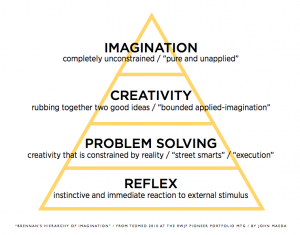Everything points to the importance of creativity as a leadership skill. How do you insert creativity into your workplace? How do you get into the right mindset to do so? It is important to recognize that creativity has several levels. Often we think of creativity when forced to make a decision. Whenever there is a reflex decision or some problem solving to handle, we pick our brains for creative ideas. Still, we often ignore the extent of what we can accomplish when we bring full-fledged creativity to the workplace.
Patti Brennan is a Professor at the School of Nursing and College of Engineering at the University of Wisconsin-Madison. She views creativity with the notion that there is a Hierarchy of Imagination that can be modeled. The hierarchy has four levels: reflex, problem solving, creativity, and imagination. At the baseline of the hierarchy is reflex. As a reflex, you come up with an instinctive response to an external stimulus. A reflex can often be creative, although it requires no exploration and often has no deep-rooted basis. There is not much thought required for a reflex, and for this reason there is no guarantee of creative success.
Up a level from reflex is problem solving. The problem solving level of creativity considers outside forces in ways that a reflex does not. Creativity needs to be practiced in order to become reflexive. Problem solving considers factors part of a reality, often incorporating “street smarts” and a means of execution. For example, imagine sales at your restaurant during lunch hours have plateaued but you want to increase sales. A reflex may be to increase marketing or offer specials to increase the number of customers. But can you accommodate more customers? There are many outside factors to consider before jumping at your first sensible idea.
True creativity is a step above problem solving, and is something that also really lends itself to success in a team environment. Brennan suggests that creativity is like “rubbing together two great ideas.” You suggest a problem-solving idea that might work. So does one of your colleagues. How do you take these two separate creative ideas and fuse them together for the best chance at success? Finding this “bounded applied-imagination” means you will have creativity that transcends basic problem solving. Collaboration is often the best way to fuel your best creative ideas taking true form.
A step above creativity is the purest form of free thought: imagination. Imagination is pure, without constraint, and unapplied. It is that true “stroke of genius” we experience when out of nowhere, we come up with our next great idea Not every great idea you have will be a figment of pure imagination. However, it is pertinent to be tuned into the part of your brain that can be unconstrained, thinking outside of the box. A crucial differentiation to make is that creativity can be cultivated and fostered, but cannot be taught. To achieve each level of imagination, a corresponding attention to persuasion is required. With persuasion, there is also a demand for empathy. As a leader, it is not only important to unlock your creativity, but also convey it in a way that encourages collaboration with fellow leaders. In the workplace, this can be achieved in a variety of ways. Don’t judge the ideas of your colleagues. Leave room for exploration, not just for yourself, but for everyone. Allow for small failures, so that no one is afraid to test new ideas. Apply the same approach to yourself too, and try something new. Getting in touch with your creativity can bring your leadership to the next level.


